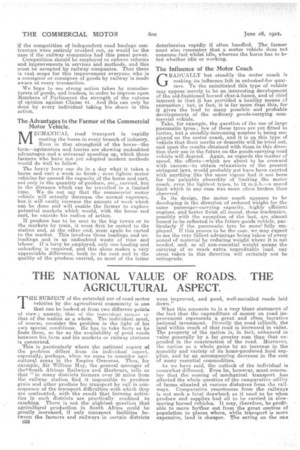THE NATIONAL VALUE OF ROADS. THE AGRICULTURAL ASPECT.
Page 2

Page 3

If you've noticed an error in this article please click here to report it so we can fix it.
THE SUBJECT of the extended use of road motor vehicles by the agricultural community is one that can be looked at from two different points of view ; namely, that of the ineividual taimei or that of the nation as a whole. The individual must, of course, consider the problem in the light of his own special conditions. He has to take facts as he finds them, so far as the availability of good roads between his farm and his markets or railway stations is concerned.
This is particularly where the national aspect of the problem differs , from its individual aspect, especially, perhaps, when we conic to consider agricultural areas in the Empire Overseas. Thus, for example, Sir William Hoy, the general manager of theeSouth African Railways and Harbours, tells us that "in many districts farmers over 20 miles frem the railway station find it impossible to produce grain and other produce for transport by rail in consequence of -the transport difficulties with which they are confronted, with the result that farming activities in such districts are practically confined to ranching. There is not the slightest question that agricultural production in South Africa could be greatly increased, if only transport facilities between the farmers and railways in certain districts
OIS were improved, and good, well-metalled roads laid down."
What this amounts to is a very blunt statement of the fact that the expenditure of money on road improvement represents a great and often lucrative national investment-. Directly the road isIbuilt, the land within reach of that road is increased in value. The property of the nation is, in fact, enhanced in value generally by a far greater sum than that expended in the construction of the road. Moreover, the nation as a whole gains by an increase in the fluantity and variety of its home-produced feed supplies, and by an accompanying decrease in the Lost of many essential commodities.
As we have said, the outlook of the individual is somewhat different. Even he, however, must remember that the coming of mechanical transport has affected the whole question of the comparative utility of farms situated at various distances from the railways. Comparative remoteness from the railways is not such a fatal drawback as it used to be when produce and supplies had all to be carried in slowmoving horsed vehicles. It may, therefore, be profitable to move further out from the great centres of population to places where, while transport is more expensive, land is cheaper. The saving on the one
side may more than balance the additional cost on the other, and distances which were at one time prohibitive, irrespective of cost, but merely on account of the time occupied in conveying • goods to the market, are now, in effect, 'brought nearer to the market, because of the comparatively rapid form of transport which the farmer can adopt if he chooses to do so, and which lends itself so admirably to co-operation. Thus, even in this country, there is room for re adjustment as to one's ideas of the comparative value of land near to or far from the railway, as the case may be. In the Empire Overseas;there is, of course, a very urgent need for ,considerable expenditure on road improvement in the direct interest of the agricultural community and for the encouragement Of settlement on the land, the ultimate object being an increase in land values and an important accession to the capital wealth of the nation as a whole.








































